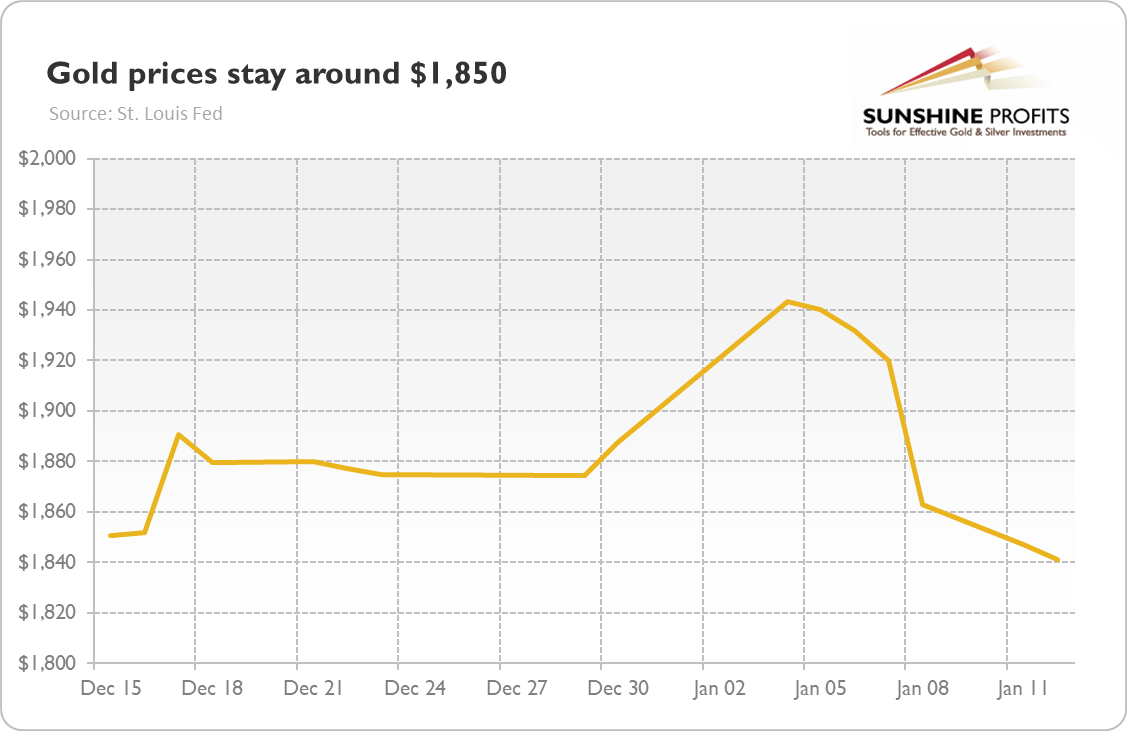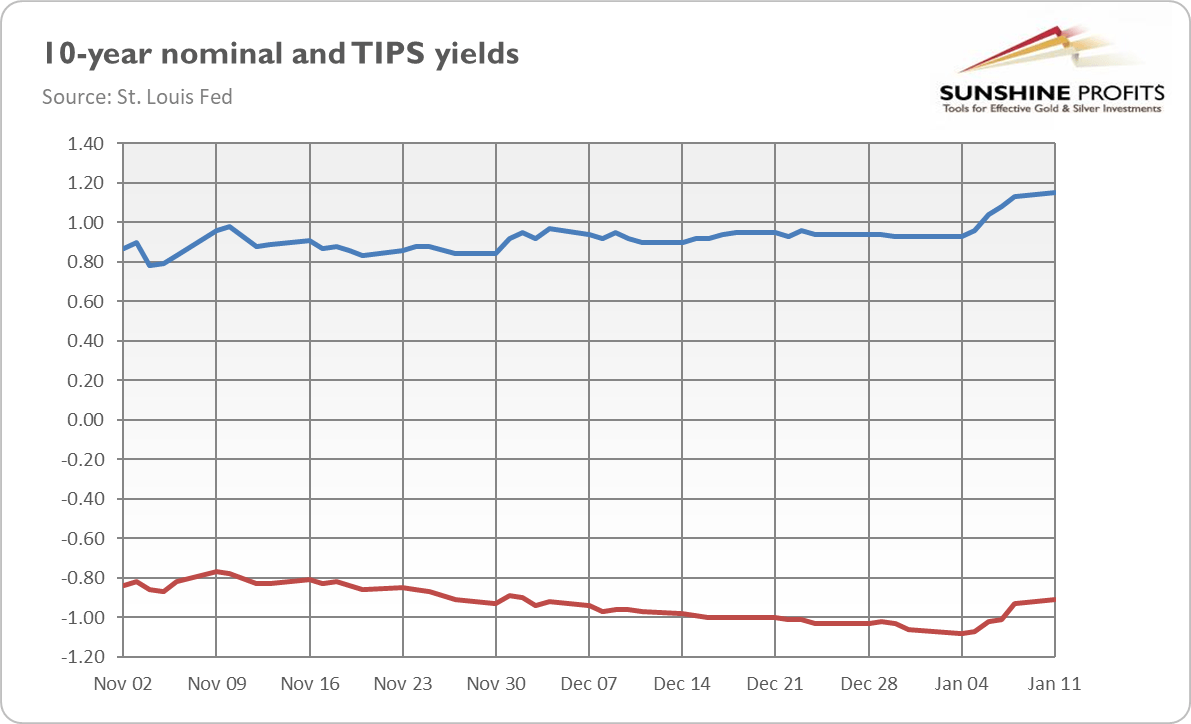The price of gold remains at $1,850, and the key drivers are higher bond yields and a stronger risk appetite.
Last week, the yellow metal tanked below $1,900 again, and it hasn't rebounded since the plunge – instead, the price of gold has stayed at around $1,850.
What happened? The main driver of the recent weakness in the precious metals market has been the Democratic victory in the Georgia Senate elections. Thanks to this trifecta, the Democrats have taken control of the White House, the House of Representatives, and the Senate. Consequently, there are lower chances of a political gridlock in Washington and higher chances of smooth cooperation between Congress and the incoming administration of Joe Biden. So, the expectations of additional economic support have risen, thereby strengthening hopes for a quicker economic recovery.
Hence, investors went euphoric and increased their risk appetite. They sold safe havens such as gold and disposed of treasuries, pushing the bond yields higher (see the chart below), which in turn hurt the yellow metal.
However, the interest rates are still historically low, and the real interest rates remain deeply in negative territory. Although some measure of normalization is standard, the return to pre-pandemic levels is unlikely. The unprecedented increase in worldwide debt implies that we are stuck in a high debt and low interest rate trap. After all, all these debts have been sustainable only because the yields have been low, so I doubt whether we will see an important rebound in them.
But the recent episode shows how sensitive gold is to the changes in the real interest rates and that gold investors – as we wrote in the latest Gold Market Overview – shouldn't forget about the possibility of an increase in the real interest rates, which is a serious downward risk for gold.
Implications for Gold
Is gold doomed now, given that the Democrats swept both the White House and Congress? Not necessarily. The macroeconomic outlook for 2021 might be worse than for 2020, as the economy should recover and monetary policy should be less dovish – but it's still positive for gold. After all, historically, gold has shined during the early phases of various economic recoveries. Some analysts even claim that we have not reached the phase of an economic recovery yet – as the liquidity crisis has transformed into a solvency crisis.
In other words, it's always important to distinguish the short-term outlook from the longer-term potential. Gold currently suffers because of the higher yields, but the long-term picture seems to be more positive. The real interest rates, which are more important for the precious metals market, have increased to a lesser extent – and they have stayed well below zero (as the chart above shows).
At some point, investors will start factoring in that a large fiscal stimulus projected by the Democrats could increase the public debt to uncomfortable levels, thereby increasing the risk of a sovereign debt crisis. They could also begin pricing in the risk of higher inflation and a larger Fed's balance sheet, as the U.S. central bank and the Treasury wouldn't welcome much higher interest rates . As a reminder, gold benefited from the easy fiscal policy in the aftermath of the first wave of the coronavirus pandemic, so it shouldn't go out of favor now. Indeed, the huge fiscal deficit combined with the current account deficit will take the so-called twin deficit to a record 25 percent of the GDP, which shouldn't be without an impact on the price of gold.
Instead, gold still has a material upside in the upcoming months, although it could shine less brightly than it did last year, at least until inflation rebounds, or until the Fed expands its accommodative monetary stance. Yes, the U.S. central bank remains dovish, but it's not eager right now to shoot from its bazooka again. So, the monetary policy will be relatively more hawkish than it was in 2020, which could limit potential gains in the gold market.
Want free follow-ups to the above article and details not available to 99%+ investors? Sign up to our free newsletter today!
All essays, research and information found above represent analyses and opinions of Przemyslaw Radomski, CFA and Sunshine Profits' employees and associates only. As such, it may prove wrong and be a subject to change without notice. Opinions and analyses were based on data available to authors of respective essays at the time of writing. Although the information provided above is based on careful research and sources that are believed to be accurate, Przemyslaw Radomski, CFA and his associates do not guarantee the accuracy or thoroughness of the data or information reported. The opinions published above are neither an offer nor a recommendation to purchase or sell any securities. Mr. Radomski is not a Registered Securities Advisor. By reading Przemyslaw Radomski's, CFA reports you fully agree that he will not be held responsible or liable for any decisions you make regarding any information provided in these reports. Investing, trading and speculation in any financial markets may involve high risk of loss. Przemyslaw Radomski, CFA, Sunshine Profits' employees and affiliates as well as members of their families may have a short or long position in any securities, including those mentioned in any of the reports or essays, and may make additional purchases and/or sales of those securities without notice.
Recommended Content
Editors’ Picks
EUR/USD edges lower toward 1.0700 post-US PCE

EUR/USD stays under modest bearish pressure but manages to hold above 1.0700 in the American session on Friday. The US Dollar (USD) gathers strength against its rivals after the stronger-than-forecast PCE inflation data, not allowing the pair to gain traction.
GBP/USD retreats to 1.2500 on renewed USD strength

GBP/USD lost its traction and turned negative on the day near 1.2500. Following the stronger-than-expected PCE inflation readings from the US, the USD stays resilient and makes it difficult for the pair to gather recovery momentum.
Gold struggles to hold above $2,350 following US inflation

Gold turned south and declined toward $2,340, erasing a large portion of its daily gains, as the USD benefited from PCE inflation data. The benchmark 10-year US yield, however, stays in negative territory and helps XAU/USD limit its losses.
Bitcoin Weekly Forecast: BTC’s next breakout could propel it to $80,000 Premium

Bitcoin’s recent price consolidation could be nearing its end as technical indicators and on-chain metrics suggest a potential upward breakout. However, this move would not be straightforward and could punish impatient investors.
Week ahead – Hawkish risk as Fed and NFP on tap, Eurozone data eyed too

Fed meets on Wednesday as US inflation stays elevated. Will Friday’s jobs report bring relief or more angst for the markets? Eurozone flash GDP and CPI numbers in focus for the Euro.

